Chapter 8
New frontiers
Where lies the future for tidal studies? On our own planet there are discoveries to be made in difficult-to-reach places such as deep-sea ecosystems. The interaction between tides and sunlight in shallow water has barely been explored. Innovative computer models allow us to reproduce the tide in the early ocean. Tidal forces are not confined to Earth. Tidal flexing of the icy moons of Jupiter appears to have created a liquid water ocean on Europa. It is possible that this ocean has the right conditions for life and space probes planned for the next few years will be able to test this possibility.
Tides and deep-sea ecosystems
The effects of the tide on marine plants and animals near the coast are relatively well understood: the shallow seas of the continental shelf are easily accessible for scientific research. The same cannot be said of the deep sea. We arguably know more about the surface of the Moon, Mars, or Venus; we have certainly mapped these environments in finer detail. The deep sea is vast. It is also challenging and expensive to sample, and our understanding of how tides shape deep-sea ecosystems is accordingly poor.
In the past few decades, cold-water coral reefs (Figure 38(a)) have grabbed the attention of the scientific community. These deep-water reefs are built by ‘non-zooxanthellate’ corals, which do not have the symbiotic algae common to their shallow, tropical counterparts—it’s too dark for photosynthesis at the depths at which they live. The classic example is the scleractinian coral Lophelia pertusa. Widely reported across the North Atlantic ocean, L. pertusa forms impressive ‘carbonate mounds’ to the west of Ireland and Scotland with heights up to 380 metres above the seabed and widths of several kilometres. Off Norway, it forms dense reefs on the continental shelf and in fjords. These mounds and reefs create hotspots of abundance and biodiversity in waters that might otherwise seem devoid of structural habitat and life.
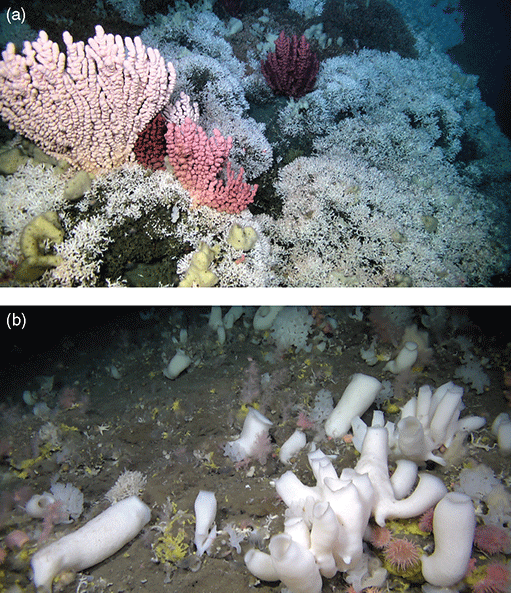
38. (a) A cold-water coral reef; and (b) an Arctic sponge ground.
Cold-water coral reefs are now fairly well studied and one thing is clear: tides are important. Corals are passive ‘suspension feeders’, extracting food particles from the water as it flows by. Tidal currents are often accelerated where they interact with prominent features on the seabed and this enhances the supply of food (and larval recruits) to the reefs. It’s easy to imagine how currents amplified from typical deep-sea speeds of just a few centimetres per second to speeds of several tens of centimetres per second can benefit such organisms. Even hungry corals can have too much of a good thing, of course, and tides help here too, ensuring they don’t get smothered by heavy loads of suspended particles settling from above.
Internal tidal motions (Chapter 6) are also thought to play an important role. They enhance turbulence in the water column, mixing nutrient-rich deep water upwards, and potentially enhancing productivity over (and food supply down to) some reefs. They intensify near-bed currents, whipping up particulate material (potential coral food) from the seabed into layers of enhanced turbidity or ‘nepheloid layers’ (from the Greek nephos, meaning cloud) and carrying them past the corals. Tidally driven internal hydraulic jumps can occur over coral reefs, causing regular, rapid injections of plankton-rich surface water downwards (known as ‘downwelling’). Tidal currents are even believed to control the precise height and shape of the carbonate mounds.
More recently, the spotlight has fallen on deep-sea sponge grounds (Figure 38(b)). The sponges are a very diverse, mostly marine group of animals with a relatively simple lifestyle that has proved successful since the Cambrian Period (541−485 million years ago). As adults, they live attached to the seabed (i.e. they are ‘sessile’). Most possess chambers of flagellated cells, the undulatory beating of which induces currents in an internal system of channels from which they extract their food (i.e. they ‘filter feed’, often processing impressive volumes of seawater). Some sponges also have their ‘exhausts’, or oscula, elevated (like chimneys) into the faster-flowing water away from the seabed, which serves to lower the pressure at the oscula relative to that at the water intake openings, or ostia, positioned lower down on the sponge. This body design creates a pressure gradient that passively drives additional flow through the sponge (from high to low pressure, or ostia to oscula), supplementing the active water pumping and conserving precious metabolic energy.
Several sponge species aggregate into grounds thought to present similar ecological benefits to cold-water coral reefs. The ‘Bird’s Nest’ sponge (Pheronema carpenteri) forms grounds along the European and north-west African continental shelves and slopes, and off the Azores archipelago. Aggregations of the ‘Russian Hat’ sponge (Vazella pourtalesi) are found off Canada’s east coast. Nine-thousand-year-old sponge reefs have been discovered off Canada’s west coast, and extensive sponge grounds occur under the ice shelves of Antarctica. Like the corals, many sponges undoubtedly benefit from some level of intensified flow and enhanced food supply. Debate still rages over the exact conditions they prefer: sponges, after all, can become ‘clogged up’.
At the Arctic Mid-Ocean Ridge, some seamounts host sponge grounds dominated by massive demosponges (resembling giant puffball mushrooms) and delicate, trumpet-shaped glass sponges. On one recently sampled seamount, the density and diversity of sponges reached a clear and impressive peak at the depth of a boundary between water masses, which was very dynamic owing to internal tidal motions. Rather frustratingly, we could only speculate on the factors most important to the sponges, based partly on what we know from cold-water coral and other deep-sea research. We may understand a lot about how the tides structure and enhance familiar ecosystems at the air–sea interface, but there is much to learn about how internal tides and tide–seabed interactions affect the enigmatic ecosystems of the deep.
Tidal interactions with sunlight
Almost all marine ecology textbooks refer to the importance of the tide in numerous shallow-water settings and contexts. It influences the horizontal banding of organisms, the vertical zonation, we see on the seashore and dominates the rhythms of everyday life, the chronobiology, of the intertidal and subtidal zones (see Chapter 1). You are unlikely, however, to read about the tide’s interactions with sunlight, despite several important ecological implications.
Sunlight entering the sea is attenuated with depth (Figure 39). The extent of the attenuation depends on the concentrations of light-absorbing and scattering materials present. If a constant fraction of the light is ‘lost’ in each metre, light energy will decay exponentially. The phenomenon is described mathematically by what’s known as the Lambert–Beer Law and the rate of attenuation with depth is normally represented by an ‘attenuation coefficient’, kd. In a tidal sea both the water depth and kd fluctuate regularly over time, and it is easy to see how light reaching the seabed must be affected by the tide.
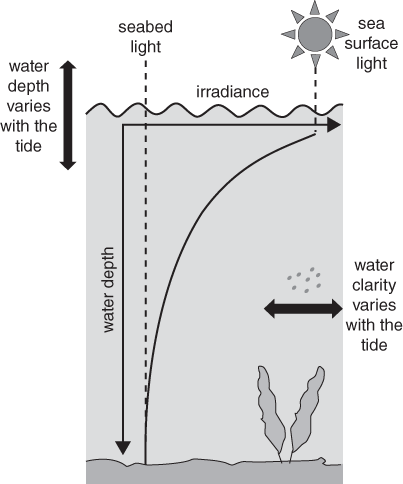
39. Tidal processes affecting seabed light.
For shallow, turbid inshore areas with a large tidal range, the patterns in light reaching the seabed can be very different to those experienced on land. For example, if low water coincides with midday there will be a period of high light levels at the seabed around this time. If, however, high water occurs at midday the seabed will be relatively dark instead. In this case, the low waters that precede and follow (at around 6 am and 6 pm for semi-diurnal tides) produce two distinct periods of light at the bed, providing there are sufficient hours of daylight.
As we noted in Chapter 1, a given location will tend to have high waters (and low waters) that always occur at the same times of day during spring tides. These times advance by about fifty minutes each day until seven to eight days later, at neap tides, the opposite scenario occurs (low waters occur at the times high waters occurred during spring tides and vice versa). A further seven to eight days sees everything back at its original time for the following spring tide. This leads to spring–neap cycles in the daily total light received by the seabed (Figure 40). It will receive more light, summed over the day, at spring tides if, for example, low water occurs at midday (and, conversely, high water of neap tides occurs at midday). The Bay of Brest in Brittany (France) is one such location. The Menai Strait in Wales (UK) has a directly opposite cycle (data shown in Figure 40); low water occurs at midday during neap tides and the bed typically receives most light then.
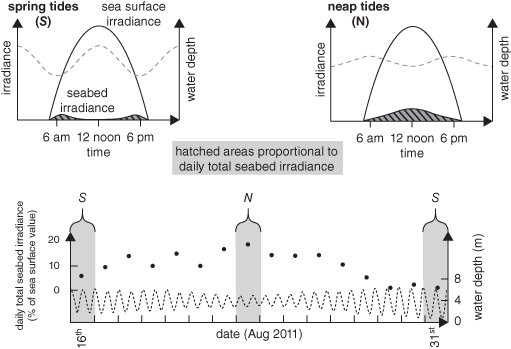
40. Daily and spring-neap patterns in seabed light at a location where high waters of spring tides occur at around midday and midnight.
At middle to high latitude sites, spring–neap cycles in daily total seabed light are affected by seasonal changes in the number of daylight hours per day. A long summertime daylength will tend to smooth out the difference in daily totals between springs and neaps: the benefits of low water occurring at midday are offset by morning and evening high waters and, conversely, the disadvantages of high water at midday are offset by morning and evening low waters. A very short winter daylength will tend to exaggerate the difference: the focus becomes much more about the water depth at around midday, which may be very different from springs to neaps.
The exponential decay of light with depth also has an important consequence: from mid-tide to low water there may be a disproportionately large gain in light at the bed (Figure 41). This gain is often greater than the loss of light around high water, so these periods do not necessarily ‘average out’ over a tidal cycle, or several, as you might expect. The result is that the tide can amplify seabed light over time, relative to a situation that is comparable but has no tide. The size of this effect is complicated by a number of factors (not least of which is the daily variation in sea surface light, relative to the timings of high and low water) and the tide can sometimes have a reducing effect. However, on certain days in the Bay of Brest, for example, we have estimated the amplification to be a factor of almost 32!
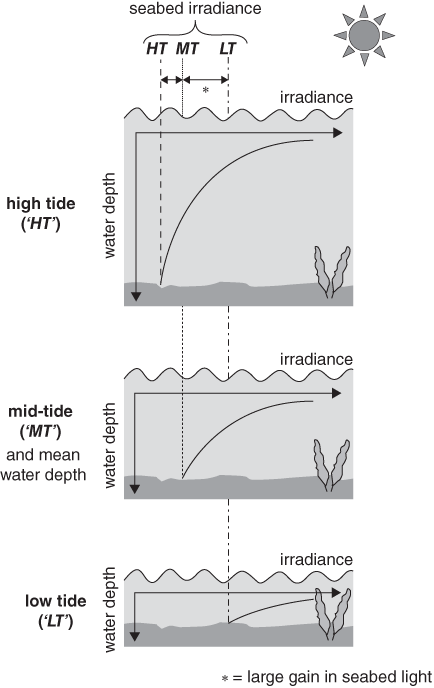
41. Tidal amplification of seabed light. Note the effect of the bed intersecting the irradiance curve at different depths (during different stages of the tide) on the light it receives.
Mathematically, the amplification that occurs depends on the attenuation coefficient (amongst other factors), as this dictates the steepness of the exponential decay curve. Light decays more rapidly with depth in turbid waters and the gain in seabed light at low water relative to mid-tide is greater in such waters than it is in those less turbid. This dependence on the attenuation coefficient leads to one final quirk of the tide’s influence on underwater light. Light at the blue and red ends of the spectrum (i.e. 400−500 nanometres and 650−700 nanometres, respectively) is the most strongly attenuated with depth in coastal waters (blue light by dissolved organic matter and suspended particles; red by the water itself) and is thus amplified most by the tide. The boosting of these wavelengths flattens somewhat the spectrum of light reaching the bed over time, which is otherwise dominated by green-yellow light.
It’s curious to think a semi-diurnal tide may cause a piece of seaweed to effectively experience two ‘daytimes’ within the single day–night cycle experienced by us terrestrial beings. A more interesting consequence, we feel, is that, providing light levels do not overwhelm or damage the photosynthetic apparatus of seabed plants and algae, and they are not limited by other factors, spring–neap patterns in daily total seabed light may drive fortnightly cycles in their photosynthesis and growth. Imagine shallow-water marine ecosystems, such as kelp forests and seagrass meadows, pulsing with enhanced primary productivity every two weeks.
What’s more, the amplification of seabed light over time by the tide probably makes seaweeds more productive (and allows them to grow deeper) in some tidal areas than in non-tidal areas with otherwise similar conditions. The likely flattening of the time-averaged spectrum of light at the bed by the tide may also prove important to seabed algae possessing greater concentrations of photosynthetic pigments primarily capturing the boosted (blue and red) wavelengths. Perhaps in this way the tide is influencing the particular species that thrive at given depths well below the low tide mark, in addition to its better-known effects on those above it. Many of these ideas need further testing, but we can be sure that if we ignore the interaction of the tide and sunlight we will make poor predictions of the energetics and productivity of several marine ecosystems that may be playing very important roles in regulating our climate and sustaining marine biodiversity.
Tides in the early ocean
The study of the tide in earlier oceans is important because of, among other things, what it can tell us about the origin of the Moon. As we have seen, tidal friction is gradually pushing the Earth and Moon apart. If we can work out the rate at which the Moon has receded in the past, we can form an estimate of the age of the Moon. This delicate task requires knowledge of tides and tidal friction in times past. There is little observational evidence to help here; this is the realm of hard-core computer modellers. Moreover, the work requires a special kind of hybrid model which can allow for the effects of continental drift on the shapes and depths of the oceans over periods of thousands of millions of years.
As tidal friction slows the Earth’s spin, the total energy and angular momentum of the Earth–Moon system are conserved. The energy lost from the Earth’s spin is passed to the ocean as heat and mixing energy (the latter ultimately raises the potential energy of the ocean). The angular momentum is given to the Moon, and, as a result, the Moon is receding from the Earth. The length of the day and that of the month are both increasing.
The length of the day and month can be calculated from the radius of the Moon’s orbit, using Kepler’s third law and the principle of conservation of angular momentum. These calculations, the results of which are shown in Figure 42, don’t require (or include) any assumptions about tidal friction. Starting at a time when the Earth and Moon were close together, the Earth was spinning rapidly and the daylength and the length of the month were both short. At this time, tidal friction caused the days to lengthen more slowly than the month and the number of days per month increased up to a maximum of thirty-one. The daylength then began to increase more rapidly than the month and the number of days per month began to fall. At some time far into the future, the length of the day will increase rapidly, and the day and the month will become equal. The Earth will then keep the same face towards the Moon and both bodies will be tidally locked to each other.
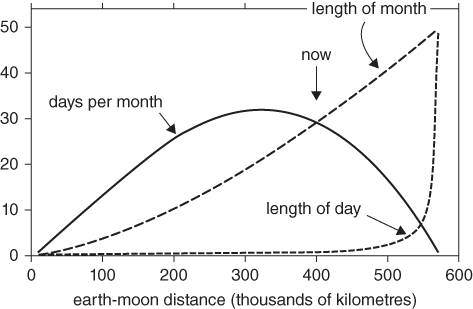
42. The length of the month and of the day (both expressed as multiples of the present day) plotted against the distance between the Earth and the Moon. The third curve shows the number of days per month, which went through a maximum sometime in the past. We are currently at the time marked by the ‘now’ arrow.
Although we can be sure of the sequence of events shown in Figure 42 it is much more difficult to put a timescale on them. The English physicist George Darwin, son of the famous naturalist Charles Darwin, likened this problem to travelling on a familiar train journey having neglected to take a timetable. The stations on the journey pass in a predictable way but the exact time the train arrives at each station cannot be predicted exactly in advance.
A timetable can be made if the speed of the train is known, or in the case of the Earth and the Moon, if the rate of loss of energy from the Earth’s spin can be calculated at all times in the past and the future. We now know (through analysis of Moon rocks collected by Apollo 14) that the age of the Moon is 4,500 million years: about the same age as the solar system. Is this figure consistent with the age of the Moon’s orbit, starting from a time when the Earth and Moon were close together and moving forwards to the present day?
We can answer that question if tidal dissipation rates (and so the rate of Earth–Moon separation) are known for all times in the past 4,500 million years. That’s a lot to ask for and at present we don’t have that information. If we assume that tidal energy dissipation has always been the same as it is today, we calculate an age of the Moon’s orbit as 1,500 million years—a factor of 3 too short. It must be, therefore, that in the early ocean, tidal dissipation rates were less, on average, than they are now. There is some observational evidence to support this conclusion. Currently the Earth–Moon distance is increasing at a rate of 38 millimetres per year and the length of the day by 0.024 milliseconds per year. Sedimentary rocks laid down 620 million years ago can be used to fix the average value of these figures over that period. These are estimated to be 22 millimetres and 0.012 milliseconds per year, about half the present values.
We can seek to confirm the fact that tidal dissipation has been less in the past by running computer models of the global ocean tide. These models combine scientific disciplines. The map of the Earth was different hundreds of millions of years ago: continents have moved over periods extending back that far and, as a result, the shape and depth of the world ocean has changed. In recent years it has been possible to combine models of continental drift with global tidal models to estimate energy dissipation over the last 250 million years. These model runs indicate that we are currently near a peak in tidal energy dissipation. The present day ocean is close to resonance with the semi-diurnal tidal forcing and the early ocean was further from resonance. Average dissipation rates over the last 250 million years were about half of what they are now. This means that the Moon receded more slowly in the past than now and allows us to increase the estimate of the age of the Moon’s orbit.
Although dissipation rates were less, on average, in the past, there were short periods when the trend was reversed and there were large tides. If we move back in time to the last ice age, for example (about 12,000 years ago), the shape of the continents and the tidal forcing were much the same as they are today but there was much more ice and, as a result, sea level was lower. Crucially, the shelf seas—currently the major source of tidal friction—were dry. Tides were confined to the ocean and their energy could not be sapped by sending tidal waves into the shallow, frictional shelf seas.
We might expect, then, that tides would have been larger during the last ice age and computer simulations agree with that assessment. The tides in the Atlantic, in particular, were larger than they are today. The models also tell us that tidal friction was also greater during the last ice age than it is now. The slightly shallower oceans at that time were closer to resonance with the semi-diurnal tidal forcing. During the last ice age, despite the lack of frictional shelf seas, more energy, rather than less, was dissipated than at the current time.
As we go further back in time it is more difficult to be sure how the tides behaved but there is one particular period which has captured the imagination. The Devonian (420−360 million years ago) was a critical time in the evolution of life on Earth. The fossil record tells us that this was when animals with backbones left the ocean to live on the land. It has been speculated that the tides were crucial to this process. Fish stranded on the beach by the receding tide would have needed to develop lungs and limbs to allow them to survive until they were rescued by the tide coming back in. Gradually they would have spent longer on land and eventually left the sea behind completely. We would not be here if it were not for the tide. As we search for advanced life in our galaxy, we should therefore look for a planet with a watery ocean and a tide-making Moon.
Tides in the solar system
The theory so painstakingly developed for the tides of our ocean can be applied to the moons and planets of the solar system; it is also possible to make close observations of these systems to test the theory. A number of unmanned space probes have flown close to the moons of Saturn and Jupiter and more are planned (Table 6). It seems very likely that important discoveries will be made about these worlds within the next few decades.
Table 6. Exploring the moons of Jupiter and Saturn
| Spacecraft | Dates | Notes |
|---|---|---|
| Voyager 1 and 2 | 1979 | Flew by Jupiter and Saturn |
| Galileo | 1995−2003 | Flew by Jupiter’s moons |
| Cassini | 2004−15 | Flew by Saturn’s moons |
| JUICE | 2022 (launch) | Mission to study Jupiter’s three icy moons—Callisto, Europa, and Ganymede |
| Europa Clipper | 2020s | Planned to fly by Europa multiple times |
The tidal force exerted by a planet on its moon is proportional to the mass of the planet, the diameter of the moon, and the inverse cube of the distance between their centres. We would therefore expect the greatest tidal effects on large moons orbiting close to a major planet. The winner here, by some distance, is Io, the closest to its parent of the four Galilean moons of Jupiter. Io is about the same size as our own Moon and orbits Jupiter at about the same distance as that of the Moon about the Earth. But, because of the large mass of Jupiter, the tidal forces exerted on Io are over 5,000 times larger than the Moon’s tidal force on Earth.
As it orbits its parent planet, Io is squeezed and stretched by the tidal force of Jupiter and that of the other Galilean moons. These tides of Io are the equivalent of the tides in the solid body of the Earth we mentioned earlier. On Io, the solid body tides are spectacular. If the material of which Io is made has about the same elasticity as that of the Earth, the tidal bulges produced will be of order 100 metres high. We can expect some dramatic effects.
Io does not disappoint. The tidal flexing of the moon causes internal heating which melts and boils the core (unlike Earth, where the interior is heated by nuclear fission, tidal heating is the principal source of heating on Io). The boiling core erupts through volcanoes on the surface sending plumes 300 kilometres into space.
Although Io experiences the strongest tidal forces in the solar system, the headlines have been grabbed by the next of Jupiter’s moons, Europa. Europa has a thick coating of water ice and calculations suggest that tidal heating may be sufficient to create a liquid water ocean beneath a surface shell of ice. Observations support this idea. First, the Hubble Space Telescope and, later, the spacecraft Galileo detected what appear to be plumes of water vapour emitted through cracks in the ice cover. The cracks themselves are caused by tidal flexing, and open and close with a tidal rhythm. Water from a Europan ocean flows up a crack as it opens, sometimes bursting out of the surface as a plume of water vapour.
The cracks allow sunlight to get into the cold, but liquid, water on Europa, creating the necessary conditions for photosynthetic life. The coldness of the water is not a problem: phytoplankton on Earth thrive in polar seas. But is there enough light? Marine algae in Earth’s ocean can manage on light levels about one hundred times less than those received at the surface of our planet. Jupiter is 5.2 times further from the Sun than Earth is. Sunlight decreases with the inverse square of distance from our Sun and light levels reduce from Earth to Europa by a factor of 27. Some light will be lost in the thin ice at the surface of the cracks, but there should be enough. It is also likely that any Europan algae would have adapted to survive at very low light levels.
Europa currently offers one of the best locations for our nearest living neighbours. Future space missions are planned to collect and analyse samples for evidence of life. The best way to look for this, without landing (and possibly contaminating the moon), may be to sample the water vapour in one of the plumes.
The tides of Jupiter’s satellites are different to those of Earth. Both Europa and Io keep the same face towards Jupiter; the strong tidal friction has long since sapped the spin energy of the moons and they now rotate about their axes with the same period that they orbit Jupiter. The moons are said to be tidally locked to their planet (the same thing has happened to our own Moon). As a result, the tidal bulges do not travel across the surface of the moons (as they do on the spinning Earth); instead tides are created by the fact that the orbits are slightly elliptical.
The change in the strength of the tidal forcing as the distance from Jupiter varies during an orbit causes the bulges to grow and shrink (by about 30 metres in the case of Europa). It is this movement that creates the flexing that produces heat. Tidal friction works to remove the eccentricity of the moons’ orbits but it is maintained in this case by the regular gravitational pull of the other large moons of Jupiter (an effect known as orbital resonance). Enceladus, the second moon of Saturn, is also thought to have a liquid ocean below an ice cover, although in this case the ice is probably too thick to allow life in the ocean.
The principles which create tides in our oceans and seas operate throughout the universe. Tidal forces are created whenever one body orbits about another. Our solar system is the closest thing we can observe to perpetual motion: the planets, comets, and asteroids orbit the Sun and the moons orbit their planets without any apparent change. It must be, however, that—gradually—tidal friction in the oceans, atmospheres, and solid bodies of the planets is sapping the kinetic energy of the solar system. The energy is transformed to heat and radiated to space, increasing entropy. These changes are so slow, however, that their consequences are unlikely to be important during the lifetime of the Sun.